Stroke Rate & the Ramp Test to Improve your Efficiency
 Karen Parnell
December 17, 2021
Karen Parnell
December 17, 2021
.png)
Paul Newsome, Swimsmooth
How to increase your Swimming Stroke Per Minute (SPM) or Arm Cadence
I get asked a lot by my swimmers and triathletes about how that can increase their Stroke per Minute (SPM) or arm cadence.
I must admit this is an area I like to work on in my own stroke but sometimes I just zone out and get into a rhythm which is slower than I should be doing to reach my goals.
What is Stroke per Minute (SPM)?
Stroke Rate or swimming arm cadence is how many strokes you take in a minute, counting both arms. 40 Strokes Per Minute (SPM) is considered a slow stroke rate; 80 SPM is a high stroke rate. You may have heard the term Stroke Length which is the distance you swim per stroke.
Elite open-water swimmers have stroke rates of between 75 and 95 strokes per minute, whereas age-group triathlon swimmers have stroke rates nearer 50 to 60 strokes per minute. If you can improve your stroke rate, without shortening your stroke length, you will swim faster.
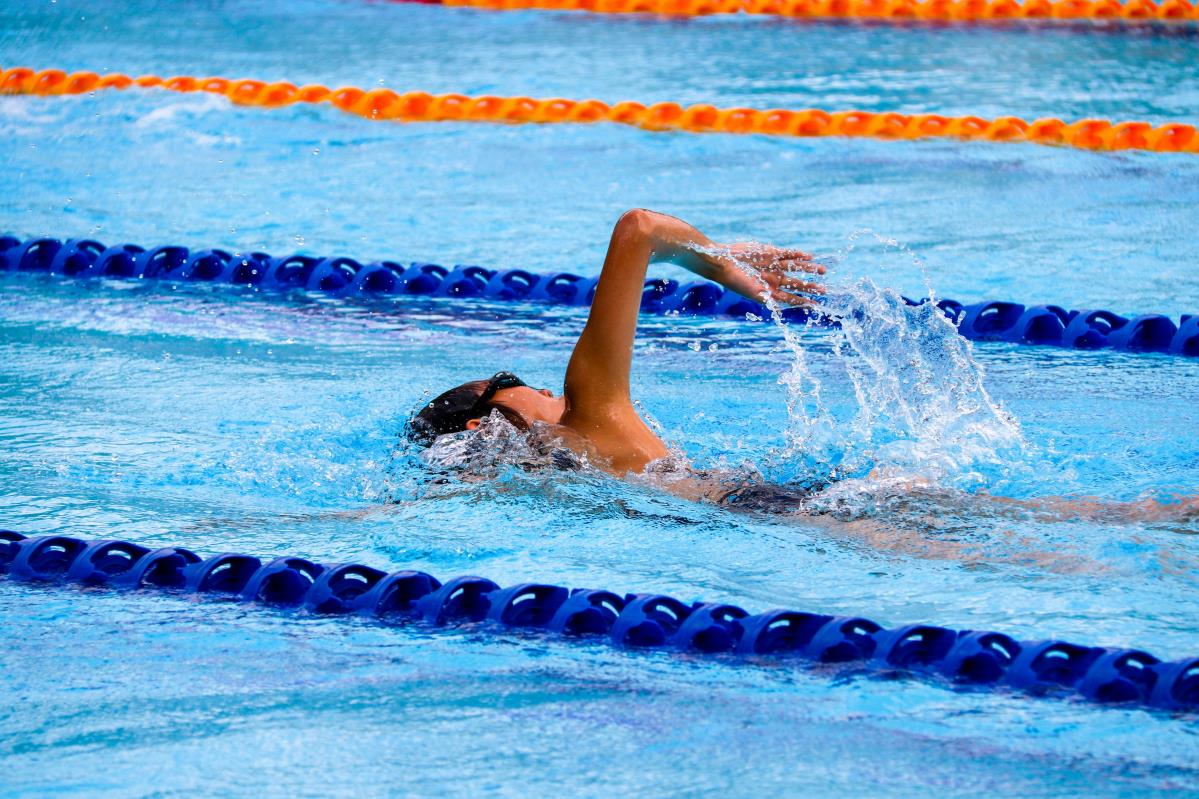
How to work out your SPM
Do a few length of the pool to warm up and get in to your natural and normal stroke.
The quickest and simplest way to find your stroke rate is to have a friend or coach time how many strokes you take in 10 seconds, rather like taking your heart rate. Then times this by 6 to get your strokes per minute.
A stroke cycle is measured from the beginning of the stroke with one arm to the beginning of the next stroke with the same arm.
This is best done in a 50m pool to avoid the time spent turning around.
How to improve you Freestyle Stroke Per Minute (SPM) and the Ramp Test
The best and easiest way improve your Freestyle or Front Crawl SPM is to use a Finis Tempo Trainer and perform a Ramp Test.
The concept of the ramp-increasing velocity test, a precursor to the swimming ramp test, was developed for the cycling ergometer by Whipp et al. in 1981, with adaptations made by other researchers like Brett to the swimming context to measure critical swimming velocity (Ucrit) in fish. Researchers Filho et al. continued to develop and refine tethered-swimming ramp tests. The swimming ramp test was popularised by Swimsmooth around 2010 using the Finis Tempo Trainer to help with the assessment.
The Ramp Test gives you a full profile of your freestyle stroke and helps you find naturally occurring sweets spots in your stroke technique. Train and race at these stroke rates to swim faster and more easily.
How to do a Ramp Test (Instructions)
You will need: A Tempo Trainer Pro. A coach or friend to time your 50m or 50-yard swims with a stopwatch and to count your strokes.
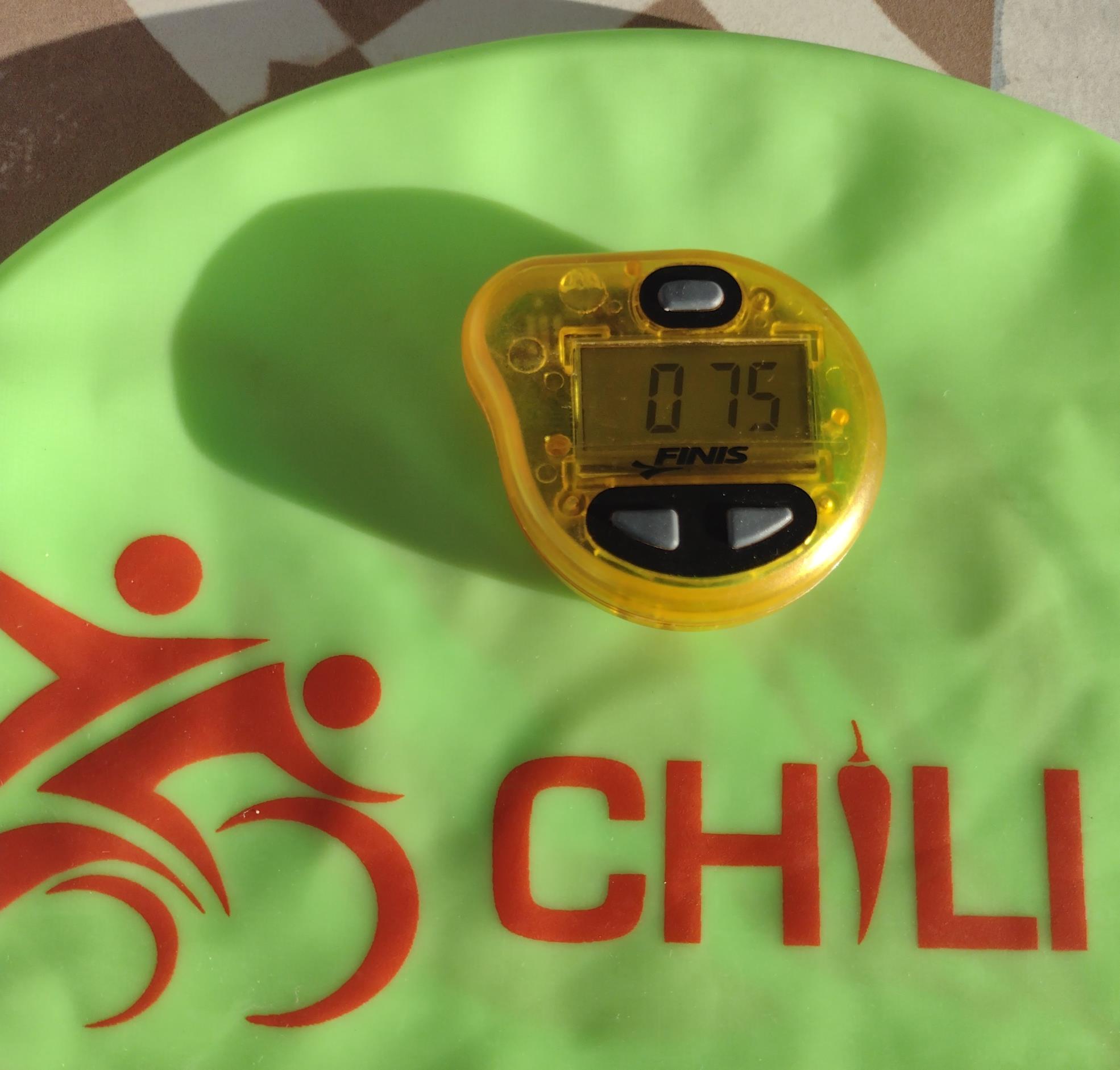
Get your FREE Swim Workouts for Triathletes Book with swim workouts, tips, technique, drills, kit and terms.
The Stroke Rate Ramp Test is a series of 50m (or 50 yard) swims with a short break in between. The stroke rate during each 50m is controlled by the Tempo Trainer Pro and gradually increases. Take 15-20 second rest between the 50m swims to change the stroke rate on the Tempo Trainer Pro.
You will need to put your Temp Trainer into Mode 3 and select 60 which is a good place to start. You will hear it beeping. Put it near your ear under your swim hat and when you set off keep your hand entries with the beat. Right arm, beep, left arm beep and so on, don´t go faster than the beep just let the Tempo Trainer control you rate.
Start the ramp test about ten strokes per minute below this natural rate or rhythm and increase it by 3 strokes per minute for each 50m swim. You can keep going as high as you like but normally 15-25 beats above your natural rate are enough to experience your full stroke range.
Ask a friend or coach to time each 50m with a stopwatch, count your strokes taken (counting both arms), your time per lap and record how that stroke rate felt to you in terms of effort. It’s a good idea to use a Rate of Perceived Exertion (RPE) scale of 1 to 10 to record your effort level where 1 is no effort at all and 10 is all out!
Take 15 to 20 second rest between each 50 metres. This is for recovery and also time to add 3 to your tempo trainer for the next 50m.
Here’s an example Ramp Test table to complete for a swimmer with a natural stroke rate around 70 strokes per minute: (Start 10-15 Stoke Lower than your Natural Stroke Rate.)

Swimming Ramp Test Table Source: Swimsmooth
To keep the test as unbiased as possible don’t try and assess the results or analyse things as you go along. Simply perform the set of 50m swims at the given stroke rate and record how each felt.
Use the tips below to interpret the results.
Should I Repeat a Ramp Test Regularly?
The test is a snapshot in time like FTP and Time Trial tests. As you work on your stroke technique over time your efficiency at different stroke rates will evolve and improve. For instance, if you work on developing your catch and feel for the water, you may gain efficiency disproportionately at higher stroke rates. I suggest you repeat the ramp test between every 6 and 12 weeks to keep up to date of your efficiency and can better decide the best strategy for you to improve your stroke and hence swim faster.
Your Swimming Stroke Sweet Spot
The Ramp Test looks at your speed and stroke efficiency over a range of stroke rates, as controlled by the Tempo Trainer Pro. Here’s an example result from a swimmer:
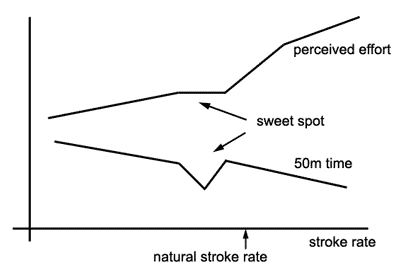
Swimming Sweet Spot Source: Swimsmooth
As stroke rate increases, we can see that the 50m split follows a downward trend – as we expect our swimmer is moving faster at higher stroke rates. We can also see that perceived effort (how hard it feels) follows an upward trend.
However, notice how there’s a definite sweet spot for this swimmer where lap time takes a dip and yet perceived effort also stays low. For this swimmer, their sweet spot comes at a slightly slower stroke rate than the natural rate at which they swim. If you get a result like this, this shows you will gain efficiency at this lower stroke rate from lengthening out your stroke technique. At first, it’s likely that swimming at this stroke rate will feel strange – the ramp test can show results you were not expecting!
Equally, depending on your stroke mechanics, you could achieve a sweet spot above your natural stroke rate. This will happen if you have a tendency to over-glide – in this case the test will show that a touch more stroke rate will help remove those dead spots and allow your swimming technique to click and so increase your efficiency.
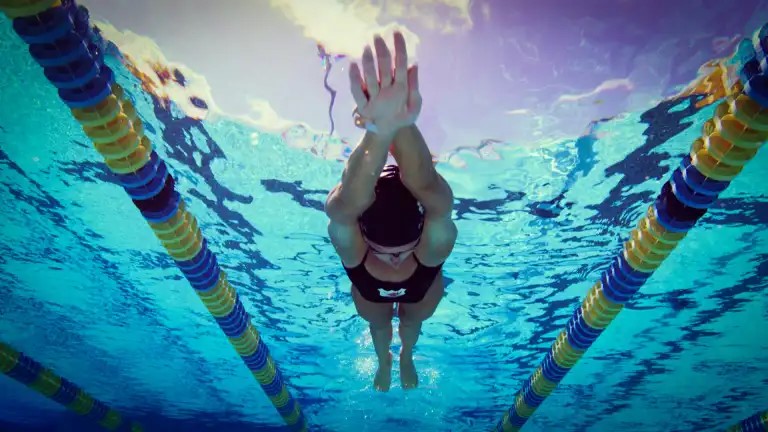
Get your FREE Swim Workouts for Triathletes Book with swim workouts, tips, technique, drills, kit and terms.
Are you Over-gliding?
Over-gliding is where you may have introduced glide into your stroke and losing efficiency from the introduction of a dead spot, normally at the front of your stroke. For example, you may leave your hand and arm out at the top of the stroke before you go in the catch and pull phases so a small slide with no effort to propel forward. This will show up on the ramp test at low stroke rates where speed will be slow for the level of effort.
As your stroke rate is increased slightly above your natural stroke rate, you gain efficiency and will often pick up some speed for the same level of effort. Or the effort level could actually drop as your stroke rate is increased.
If the ramp test shows you are more efficient at a slightly faster stroke rate than is natural, then you may need to increase stroke rate. By setting the Tempo Trainer Pro to a slightly faster rate in training you will soon adapt and give your swimming a real lift in efficiency.
So, if you want to increase your stroke rate or SPM add a second higher than your normal stroke rate and swim to the beat.
You may find this easy at first but more taxing as you swim further. Once this is your “new normal” SPM then add 1 more second on. This can take a week or so to bed in the new SPM.
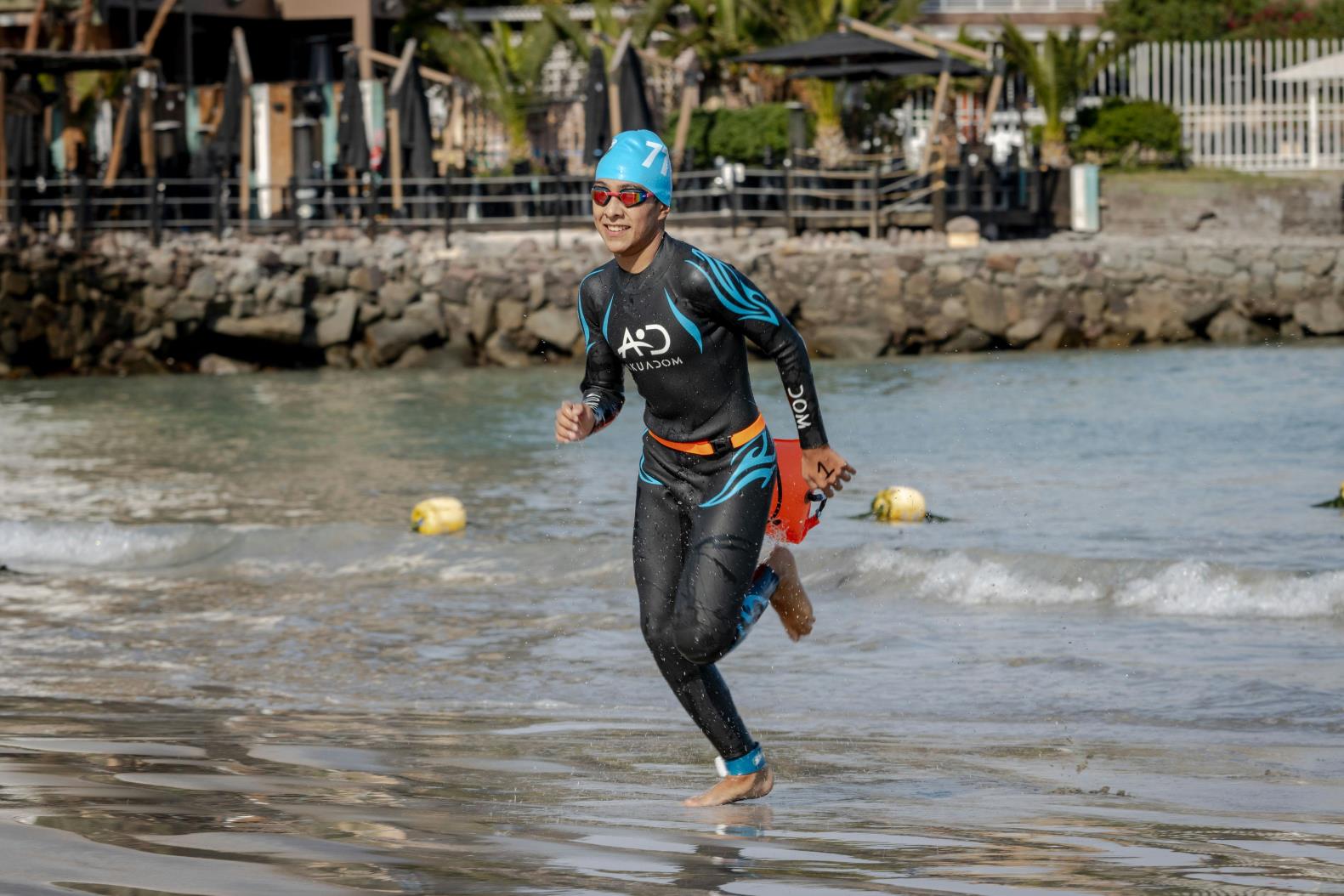
Get your FREE Open Water Swimming Sessions E-Book
Are you Fighting The Water?
As stroke rate increases, every swimmer gets to a point where they are fighting the water and their efficiency falls away. You’ll soon see this in your Ramp Test results when it happens: you won’t be moving much faster, but your level of effort will be much higher.
Do you have Two Sweet Spots?
You may discover you have more than one sweet spot in your stroke. This is more common with fast swimmers but can show in any swimmer’s results. The two sweet spots are normally found at around a steady level of effort and then at a faster threshold level suitable for intervals and racing:
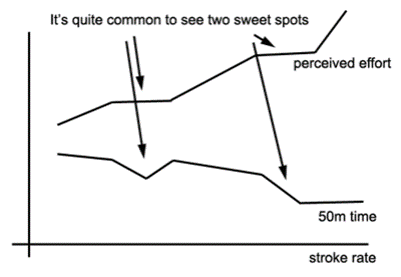
Stroke Sweet Spots Source: Swimsmooth
By being aware of these peaks in your swimming efficiency you can use them in training and racing to optimise your speed.
Conclusion: Increasing you Stroke Per Minute (SPM)
If you have completed a ramp test as detailed above and find that you need to increase your stroke rate, then using a Tempo Trainer in Mode 3 and increasing it gradually over time will help you do this.
Remember to do a Ramp Test regularly (about every 6 weeks) to make sure you are making progress with both your Stroke Rate, Stroke Length and Speed.
Check out the Swimsmooth swim plans here.
For more information on Swimsmooth.
Get your FREE Swim Workouts for Triathletes Book with swim workouts, tips, technique, drills, kit and terms.
About ChiliTri and Coach Karen
Karen Parnell is a Level 3 British Triathlon and IRONMAN Certified Coach, 8020 Endurance Certified Coach, WOWSA Level 3 open water swimming coach and NASM Personal Trainer and Sports Technology Writer.
Karen has recently completed a postgraduate MSc in Sports Performance Coaching at the University of Stirling.
Need a training plan? I have plans on TrainingPeaks and FinalSurge:
I also coach a very small number of athletes one to one for all triathlon and multi-sport distances, open water swimming events and running races, email me for details and availability. Karen.parnell@chilitri.com
Get your FREE Guide to Running Speed and Technique
Get your FREE Swim Workouts for Triathletes E-book
Get your FREE Open Water Swimming Sessions E-Book
Frequently Asked Questions (FAQ) for Stroke Rate and Triathlon Swimming
What is Stroke Rate measure in?
Stroke Rate is how many strokes you take in a minute, counting both arms. 40 Strokes Per Minute (SPM) is considered a slow stroke rate; 80 SPM is a high stroke rate. Connected to this is your stroke length which shows what distance you swim by stroke.
What is a good Stroke Rate?
Elite open-water swimmers have stroke rates of between 75 and 95 strokes per minute, whereas age-group triathlon swimmers have stroke rates nearer 50 to 60 strokes per minute. If you can improve your stroke rate, without shortening your stroke length, you will swim faster.
What is a good Stroke Rate for 25m?
Stroke count is the number of strokes you take each length of the pool. You count both your left and your right arm strokes and most age group swimmers generally require somewhere between 16-30 strokes to complete 1 length of a 25m pool.
What is good average distance per stroke DPS?
Swimming or pulling with 100% stroke distance efficiency, you should be able to travel approximately 5 feet or 1.5 metres . With each freestyle arm stroke (10 feet or 3 metres for each right-left stroke cycle).
What is a good time for 750m sprint triathlon swim?
Realistically, for an open water 750m swim, we want to aim to be under the 20 minute mark. We know that 15 minute swim times can be done by those swimming at 2:00/100m but 20 mins is achievable for those swimming 2:40s or faster.
What is a good time for 1500m Olympic triathlon swim?
A good 1500m time is 30:08. This is the average 1500m time across all ages and genders. Elites will be aiming for sub 18 minutes!
What is an good time for a 1900m IRONMAN 70.3 triathlon swim?
The average mid-pack male swimmer swimming at 2.06/100m for a 70.3 which is 40 minutes. The average mid-pack lady swimmer swims at 2.12/100m for a 70.3 which is 42 minutes. So a good time would be 35 minutes.
Marten Van Riel currently has the fastest 70.3 time ever recorded, a 3:26:06 in Dubai 2022. His swim was 22:49 swim (1:12 min/100m).
What is a good time for a 3800m IRONMAN triathlon swim?
The average mid-pack male swimmer swims at 2.02/100m for an Ironman swim which is 1 hour 18 minutes. The average mid-pack lady swims at 2.09/100m for an Ironman which is 1 hour 22 minutes. So a good time would be around 1 hour 10 minutes.
The fastest Ironman swim time for both men and women was recorded at Ironman Chattanooga in 2014 with a down-current swim. For the men, Barrett Brandon needed 38:06, which translates to a pace of 1 min/100m. On the women's field, Anna Cleaver completed the swim in 39:56 (1:03/100m).
References
Your Ideal Stroke Rate | U.S. Masters Swimming (usms.org)
Pessôa Filho DM, Siqueira LOC, Simionato AR, Espada MAC, Pestana DS, DiMenna FJ. A Rapidly-Incremented Tethered-Swimming test for Defining Domain-Specific Training Zones. J Hum Kinet. 2017 Jun 22;57:117-128. doi: 10.1515/hukin-2017-0053. PMID: 28713464; PMCID: PMC5504584.
Whipp BJ, Davis JA, Torres F, Wasserman K. A test to determine parameters of aerobic function during exercise. J Appl Physiol Respir Environ Exerc Physiol. 1981 Jan;50(1):217-21. doi: 10.1152/jappl.1981.50.1.217. PMID: 6782055.
K.E Jain, J.C Ha,ilton, A.P Farrel.Use of a Ramp Velocity Test to Measure Critical Swimming Speed in Rainbow Trout (Onchorhynchus mykiss)
#blog #chilitri #strokeperminute #swimming #sweetspot #ramptest #spm #triathlon #swimmingtrainingplan #cyclingtrainingplan #runningtrainingplan #swimming #cycling #running
